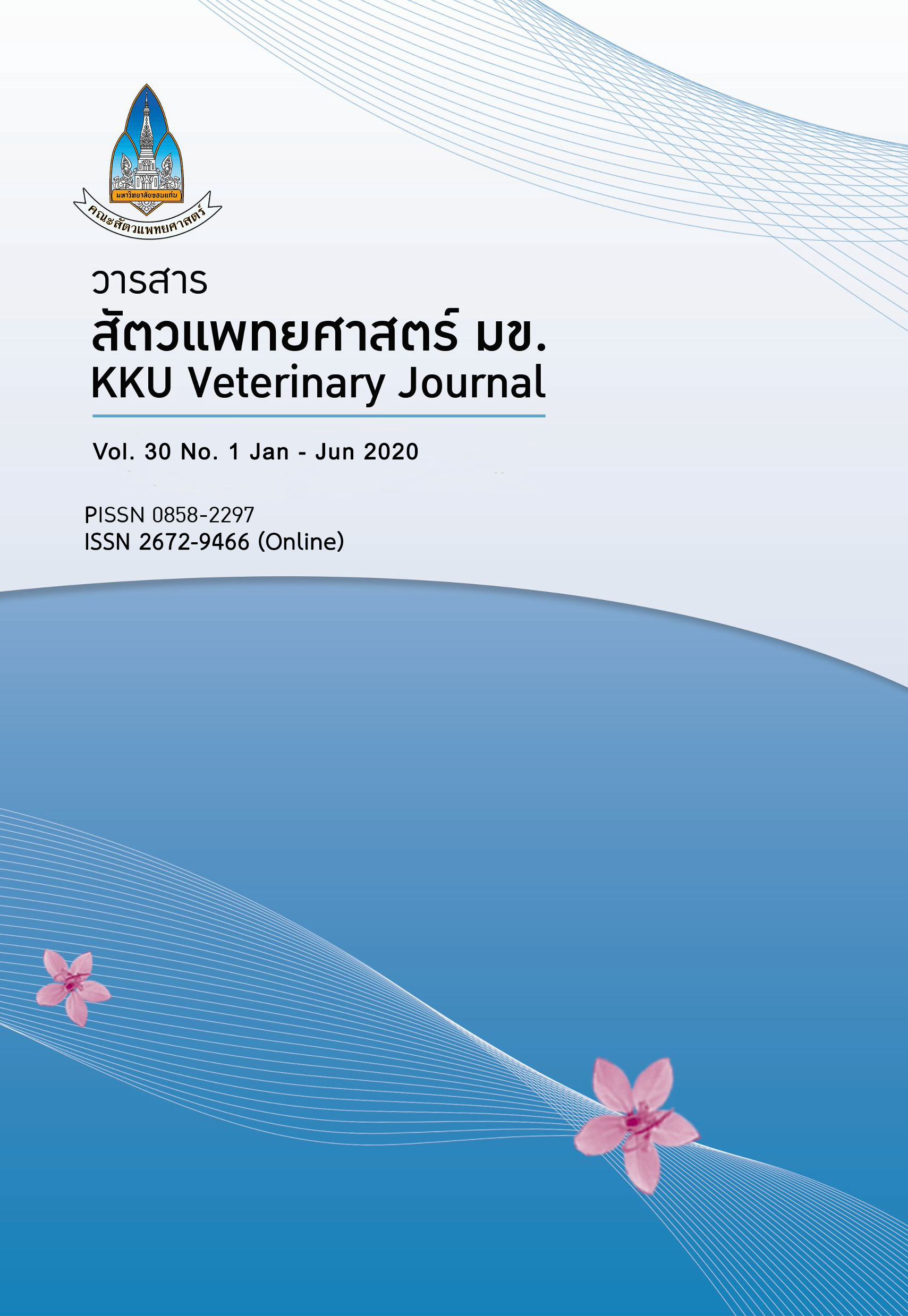ความสูญเสียทางเศรษฐกิจจากโรคปากและเท้าเปื่อยในฟาร์มโคนม ในสหกรณ์โคนมแม่วาง เชียงใหม่
Main Article Content
บทคัดย่อ
วัตถุประสงค์ เพื่อศึกษาถึงความสูญเสียทางเศรษฐกิจจากการเกิดโรคปากและเท้าเปื่อยในฟาร์มโคนม ในสหกรณ์โคนมแม่วาง จังหวัดเชียงใหม่ เนื่องมาจากว่าโรคปากและเท้าเปื่อยเป็นโรคระบาดที่สำคัญโรคหนึ่งในอุตสาหกรรมการเลี้ยงสัตว์ทั่วโลกซึ่งมักจะเกิดขึ้นในสัตว์กีบคู่และแพร่กระจายได้อย่างรวดเร็ว สำหรับการเลี้ยงโคนมในประเทศไทยโรคปากและเท้าเปื่อยถือว่าเป็นโรคระบาดที่ส่งผลกระทบอย่างรุนแรงต่อฟาร์มโคนม สัตว์ที่ติดเชื้อจะแสดงอาการจำเพาะคือ เกิดตุ่มใสบริเวณเท้า ปาก หรือเต้านม และมีอาการอื่นๆ คือ มีไข้สูง เดินกะเผลก ความอยากอาหารลดลง ผลผลิตน้ำนมดิบลดลง
วิธีการศึกษา เป็นการศึกษาเชิงวิเคราะห์แบบตัดขวาง โดยใช้วิธีสัมภาษณ์แบบมีโครงสร้างกับเกษตรกรผู้เลี้ยงโคนม 51 ฟาร์ม และใช้วิธีการทางเศรษฐศาสตร์ที่เรียกว่าการวิเคราะห์ต้นทุน-ผลประโยชน์ สำหรับการวิเคราะห์ผลเสียทางเศรษฐกิจที่เกิดขึ้นจากการเกิดโรคปากและเท้าเปื่อยในฟาร์มโคนม
ผลการศึกษา ฟาร์มโคนม 51 ฟาร์ม มีต้นทุนการผลิตน้ำนมดิบต่อฟาร์มสูงสุด 22.28 บาท/กิโลกรัม ต่ำสุด 12.10 บาท/กิโลกรัม ค่ากลาง 16.54 บาทต่อกิโลกรัม ค่าเฉลี่ย 16.93 บาท/กิโลกรัม มาจากต้นทุนคงที่ต่อฟาร์มสูงสุด 7.64 บาท/กิโลกรัม ต่ำสุด 1.89 บาท/กิโลกรัม ค่ากลาง 3.60 บาท/กิโลกรัม ค่าเฉลี่ย 3.65 บาท/กิโลกรัม ต้นทุนผันแปรต่อฟาร์มสูงสุด 18.75 บาท/กิโลกรัม ต่ำสุด 8.27 บาท/กิโลกรัม ค่ากลาง 13.28 บาท/กิโลกรัม ค่าเฉลี่ย 13.25 บาท/กิโลกรัม โดยมีโคนม 393 ตัว จากทั้งหมด 704 ตัวแสดงอาการป่วย คิดเป็นร้อยละ 55.82 มีมาตรการจากสหกรณ์แจ้งให้เกษตรกรงดส่งน้ำนมดิบระหว่าง 15-30 วัน เกิดความสูญเสียปริมาณน้ำนมต่อฟาร์มสูงสุด 15,000 กิโลกรัม ต่ำสุด 1,000 กิโลกรัม ค่ากลาง 5,700 กิโลกรัม มีฟาร์มที่สูญเสียทางเศรษฐกิจจากการงดส่งน้ำนมดิบสูงสุด 267,000 บาท/ฟาร์ม ต่ำสุด 17,500 บาท/ฟาร์ม ค่ากลาง 102,600 บาท/ฟาร์ม ในช่วงของการเกิดโรคสูญเสียน้ำนมดิบรวม 283,800 กิโลกรัม เป็นเงินกว่า 5 ล้านบาท
ข้อสรุป จากผลการศึกษาสรุปได้ว่าความสูญเสียทางเศรษฐกิจจากโรคปากและเท้าเปื่อยในฟาร์มโคนมของแต่ละฟาร์มมีความแตกต่างกันขึ้นอยู่กับปัจจัยดังต่อไปนี้ ได้แก่ ต้นทุนการผลิตในฟาร์มนั้นๆ ปริมาณน้ำนมดิบที่ผลิตได้ ระยะเวลาในการงดส่งนม ซึ่งจะเห็นได้จากฟาร์มขนาดใหญ่มีผลผลิตน้ำนมดิบปริมาณสูง เมื่อมีการงดส่งน้ำนมดิบก็จะส่งผลทำให้ความสูญเสียทางเศรษฐกิจสูงกว่าฟาร์มขนาดกลางและฟาร์มขนาดเล็ก
Article Details
เอกสารอ้างอิง
Bureau of disease control and veterinary services, 2016. Foot-And- Mouth status in 2016.
Demir P, Aydin E, Bozukluhan K, 2017. The assessment of produc- tion loss caused by foot-and-mouth disease on animal farms in the northeast Anatolia region in Turkey. J Vet Med Res 4, 1079.
Department of livestock development, 2017. Livestock information in 2017, Information and Communication Technology center.
FAO, 2006. Foot-and-Mouth Disease Situation worldwide and ma- jor epidemiological events in 2005-2006. FAO EMPRES 1-2007.
Knight-Jones TJD, 2013. The economic impacts of foot and mouth disease – What are they, how big are they and where do they occur? Prev Vet Med 112, 161-173.
Lyons NA, Alexander N, Stärk KDC, Dulu TD, Sumption KJ, James AD, Rushton J, Fine PEM, 2015. Impact of foot-and-mouth disease on milk production on a large-scale dairy farm in Kenya. Prev Vet Med 120,177-186.
OIE, 2015. List of FMD free Member Countries, Animal health in the world.
Office of Regional Livstock 5, 2016. Dairy farm and milk report in upper-north part of Thailand in 2016-2017, Department of Livestock Development.
Singh B, Prasad S, Sinha DK, Verma MR, 2013. Estimation of eco- nomic losses due to foot and mouth disease in India. In- dian J Anim Sci 83, 964-970.


